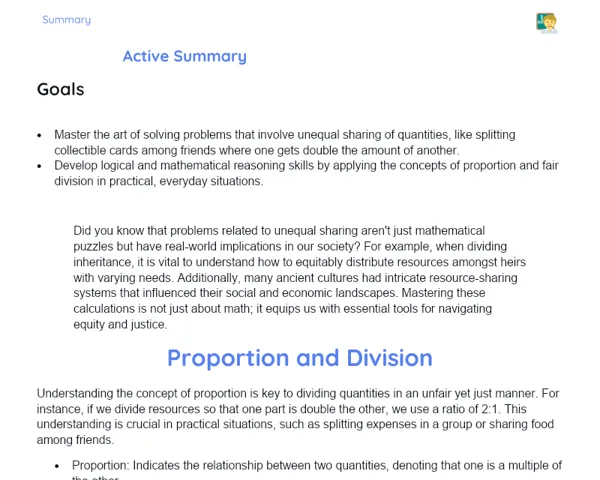Summary Tradisional | Perimeter
Contextualization
The perimeter is a basic concept in geometry that represents the total length of all the sides of a geometric figure. Picture needing to put up a fence around a park or assess the boundary of a garden; the measurement you’re after to determine how much material you'll need is the perimeter. In simple terms, the perimeter helps us understand the complete boundary of a shape, whether it’s a triangle, square, or pentagon.
This measurement has numerous practical uses in our daily lives. For instance, when we want to find out how much fencing is needed to enclose a piece of land or calculate the amount of ribbon to wrap a gift, we're essentially calculating the perimeter. Even in constructing racing tracks, knowing the perimeter is crucial to figure out how many laps are required to cover a specific distance. Thus, grasping and calculating the perimeter is a handy and practical skill we encounter in various day-to-day tasks.
To Remember!
Definition of Perimeter
The perimeter refers to the total distance around a geometric figure. In simpler terms, it is the sum of the lengths of all the sides of a figure. For instance, in a square, the perimeter is the total of its four sides. For a triangle, the perimeter would be the total length of its three sides.
Understanding perimeter is essential for solving real-world problems. Consider that you need to fence in a garden; to find out how much fencing you’ll require, you must calculate the garden's perimeter. Likewise, if you need to determine how much ribbon is needed to wrap a box, calculating the perimeter of the box is crucial for knowing the exact length of ribbon needed.
Plus, concepts of perimeter are applied across various fields like architecture, construction, and even sports. For example, when constructing a racetrack, it's vital to know the perimeter to figure out how many laps are necessary to cover a certain distance.
-
The perimeter is the sum of the lengths of all sides of a figure.
-
It is a practical measure used in various everyday situations.
-
Calculating perimeter is fundamental in fields like architecture and construction.
Perimeter of a Triangle
To find the perimeter of a triangle, you simply add up the lengths of its three sides. There are various types of triangles—equilateral, isosceles, and scalene—and the formula to calculate perimeter applies to all of them. For instance, in an equilateral triangle, where all sides are equal, the sum of the three sides gives the perimeter.
Here's a practical example: if a triangle has sides measuring 3 cm, 4 cm, and 5 cm, the perimeter would be 3 cm + 4 cm + 5 cm, totaling 12 cm. It’s important to ensure that all measurements are in the same unit before summing them.
Being able to calculate the perimeter of triangles is beneficial in various scenarios, like determining the length of a triangular fence or creating accurate geometric designs in engineering or architectural projects.
-
The perimeter of a triangle is the sum of the lengths of its three sides.
-
Applies to all types of triangles: equilateral, isosceles, and scalene.
-
Useful in numerous practical applications, like fencing and engineering projects.
Perimeter of a Square
To find the perimeter of a square, you must multiply the length of one side by four, as all sides of a square are equal. For example, if each side of a square is 6 cm, the perimeter will be 4 times 6 cm, which equals 24 cm.
This simple formula allows for quick calculations of the perimeter of squares in practical situations, like figuring out how much material is needed to cover a square surface or to encircle a square area with a fence.
Moreover, the concept of square perimeters is commonly employed in design and construction projects where precise calculation of dimensions is vital for efficiency and cost-effectiveness.
-
The perimeter of a square is found by multiplying the length of one side by four.
-
A straightforward and practical formula for calculating square perimeters.
-
Relevant in design, construction, and various real-life situations.
Perimeter of a Pentagon
To find the perimeter of a pentagon, simply add the lengths of its five sides together. In a regular pentagon, where all sides are equal, you can multiply the length of one side by five. For example, if each side of a regular pentagon measures 7 cm, then the perimeter is 5 times 7 cm, or 35 cm.
However, if the pentagon is irregular, meaning the sides have different lengths, you must add each side up individually. For instance, if a pentagon’s sides measure 5 cm, 6 cm, 7 cm, 8 cm, and 9 cm, the perimeter sums up to 35 cm.
Calculating the perimeter of pentagons is significant in practical scenarios, like determining materials needed for a pentagonal frame or assessing length for a fence to enclose a pentagonal area.
-
The perimeter of a pentagon is the sum of the lengths of its five sides.
-
For regular pentagons, multiply the length of one side by the number of sides.
-
Useful in practical situations such as pentagonal frames and fencing.
Key Terms
-
Perimeter: The measurement of the boundary of a geometric figure.
-
Triangle: A geometric figure consisting of three sides.
-
Square: A geometric figure with four equal sides.
-
Pentagon: A geometric figure with five sides.
-
Geometric figure: Any shape with a defined boundary, like a triangle, square, or pentagon.
-
Calculation: The mathematical process of determining a value.
-
Practical applications: Utilization of knowledge in everyday situations, like fencing properties or measuring ribbon for wrapping gifts.
Important Conclusions
In this lesson, we delved into the concept of perimeter and its applications across different geometric figures like triangles, squares, and pentagons. We understood that perimeter measures the boundary of a figure and can be calculated by adding the lengths of all its sides. The practical relevance of perimeter was highlighted, showing its application in daily tasks such as fencing land and measuring ribbon for gift wrapping.
We went through specific formulas for calculating the perimeter of triangles, squares, and pentagons. For triangles, we sum the three sides; for squares, we multiply the length of one side by four; and for pentagons, we either sum the five sides or multiply the length of one side by the number of sides in the case of a regular pentagon. Grasping these formulas is vital for tackling practical challenges and applying knowledge in real-life situations.
The significance of the topic lies in its practical applicability in numerous fields like engineering, architecture, and everyday activities. I encourage you to further explore this subject by practicing perimeter calculations with different geometric figures and thinking of new scenarios where this knowledge can be applied.
Study Tips
-
Practice calculating the perimeter of various geometric figures at home using everyday items like notebooks, boxes, and toys.
-
Review the examples discussed in class and redo the calculations to ensure comprehension of methods for figuring out perimeter for triangles, squares, and pentagons.
-
Utilize online resources, including educational videos and interactive exercises, to enhance your understanding of perimeter calculations and their practical usages.



